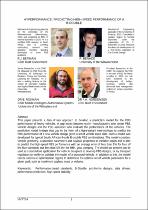JavaScript is disabled for your browser. Some features of this site may not work without it.
- ResearchSpace
- →
- Research Publications/Outputs
- →
- Conference Publications
- →
- View Item
| dc.contributor.author |
Berman, Robert J

|
|
| dc.contributor.author |
Benade, R

|
|
| dc.contributor.author |
Rosman, Benjamin S

|
|
| dc.contributor.author |
Nordengen, Paul A

|
|
| dc.date.accessioned | 2017-06-07T08:02:25Z | |
| dc.date.available | 2017-06-07T08:02:25Z | |
| dc.date.issued | 2016-11 | |
| dc.identifier.citation | Berman, R.J., Benade, R., Rosman, B.S. et al. 2016. Hyperformance: predicting high-speed performance of a b-double. HVTT14 - Future Pathways, 5-18 November 2016, Rotorua, New Zealand | en_US |
| dc.identifier.uri | https://www.benjaminrosman.com/papers/hvtt16.pdf | |
| dc.identifier.uri | http://rcaforum.org.nz/sites/public_files/images/2016_HVTT14_Conference_2016_Programme.PDF | |
| dc.identifier.uri | http://hdl.handle.net/10204/9237 | |
| dc.description | HVTT14 - Future Pathways, 5-18 November 2016, Rotorua, New Zealand | en_US |
| dc.description.abstract | This paper presents a data driven approach to develop a prediction model for the PBS performance of heavy vehicles. A gap exists between trailer manufacturers who create PBS vehicle designs and the PBS assessors who evaluate the performance of the vehicles. The prediction model bridges that gap in the form of a light-weight methodology to predict the PBS performance of a new vehicle design given a set of vehicle input data. Such a model was developed for typical South African 9-axle B-double PBS combinations. The model considers vehicle geometry, suspension parameters and payload properties as variable inputs and is able to predict the high-speed PBS performance with an average error of less than 1% for four of the five standards and less than 5% for the fifth, yaw damping. The model we present can be used as a standalone application for vehicle designers to develop PBS designs, or by transport regulators to verify or validate the results of a proposed vehicle. In addition to this, the model can be used in an optimisation regime to determine the optimal set of vehicle parameters for a given goal, such as maximum payload mass or volume. | en_US |
| dc.language.iso | en | en_US |
| dc.relation.ispartofseries | Worklist;18206 | |
| dc.subject | Performance-based standards | en_US |
| dc.subject | B-Double | en_US |
| dc.subject | Pro-forma designs | en_US |
| dc.subject | Data driven | en_US |
| dc.subject | Performance prediction | en_US |
| dc.subject | High-speed stability | en_US |
| dc.title | Hyperformance: predicting high-speed performance of a b-double | en_US |
| dc.type | Conference Presentation | en_US |
| dc.identifier.apacitation | Berman, R. J., Benade, R., Rosman, B. S., & Nordengen, P. A. (2016). Hyperformance: predicting high-speed performance of a b-double. http://hdl.handle.net/10204/9237 | en_ZA |
| dc.identifier.chicagocitation | Berman, Robert J, R Benade, Benjamin S Rosman, and Paul A Nordengen. "Hyperformance: predicting high-speed performance of a b-double." (2016): http://hdl.handle.net/10204/9237 | en_ZA |
| dc.identifier.vancouvercitation | Berman RJ, Benade R, Rosman BS, Nordengen PA, Hyperformance: predicting high-speed performance of a b-double; 2016. http://hdl.handle.net/10204/9237 . | en_ZA |
| dc.identifier.ris | TY - Conference Presentation AU - Berman, Robert J AU - Benade, R AU - Rosman, Benjamin S AU - Nordengen, Paul A AB - This paper presents a data driven approach to develop a prediction model for the PBS performance of heavy vehicles. A gap exists between trailer manufacturers who create PBS vehicle designs and the PBS assessors who evaluate the performance of the vehicles. The prediction model bridges that gap in the form of a light-weight methodology to predict the PBS performance of a new vehicle design given a set of vehicle input data. Such a model was developed for typical South African 9-axle B-double PBS combinations. The model considers vehicle geometry, suspension parameters and payload properties as variable inputs and is able to predict the high-speed PBS performance with an average error of less than 1% for four of the five standards and less than 5% for the fifth, yaw damping. The model we present can be used as a standalone application for vehicle designers to develop PBS designs, or by transport regulators to verify or validate the results of a proposed vehicle. In addition to this, the model can be used in an optimisation regime to determine the optimal set of vehicle parameters for a given goal, such as maximum payload mass or volume. DA - 2016-11 DB - ResearchSpace DP - CSIR KW - Performance-based standards KW - B-Double KW - Pro-forma designs KW - Data driven KW - Performance prediction KW - High-speed stability LK - https://researchspace.csir.co.za PY - 2016 T1 - Hyperformance: predicting high-speed performance of a b-double TI - Hyperformance: predicting high-speed performance of a b-double UR - http://hdl.handle.net/10204/9237 ER - | en_ZA |






